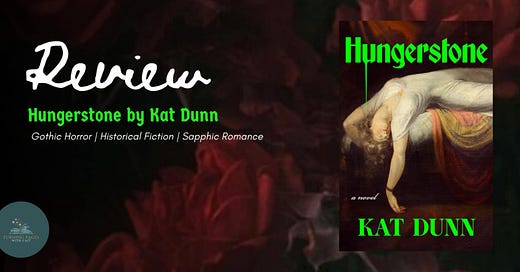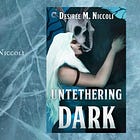[Book Review] 'Hungerstone' by Kat Dunn
'Hungerstone' is a decadent feast of a read that is bound to leave readers fully sated.
Sometimes it is not enough to bemoan or to plead with eloquence. Sometimes the only way to be heard is to rage and to scream. In moments of powerlessness, action and agency can come clawing to the forefront with froth on the lips and fangs bared. Hungerstone opens its pages, both timely and timeless in its brazen challenge of the cultural/political moment, and invites the raging inner beast in all of us out to play.
Hungerstone is the latest novel of author Kat Dunn, who has made a name for herself with other gothic fantasies and historical fictions like Bitterthorn and her Battalion of the Dead trilogy. Hungerstone continues Dunn’s tradition of rich prose and sumptuous sapphic narratives.
Before we begin, allow me to introduce you to the stirring allure of Hungerstone and the wild moors of Nethershaw:
For what do you hunger, Lenore?
Lenore is the wife of steel magnate Henry, but ten years into their marriage, the relationship has soured and no child has arrived to fill the distance growing between them. Henry's ambitions take them out of London and to the imposing Nethershaw manor in the countryside, where Henry aims to host a hunt with society’s finest. Lenore keeps a terrible secret from the last time her husband hunted, and though they never speak of it, it haunts their marriage to this day.
The preparations for the event take a turn when a carriage accident near their remote home brings the mysterious Carmilla into Lenore's life. Carmilla who is weak and pale during the day but vibrant at night; Carmilla who stirs up a hunger deep within Lenore. Soon girls from local villages begin to fall sick before being consumed by a bloody hunger.
Torn between regaining her husband's affection and Carmilla's ever-growing presence, Lenore begins to unravel her past and in doing so, uncovers a darkness in her household that will place her at terrible risk . . .
There is a comfortable familiarity to Hungerstone for lovers of gothic novels. The wildness of the moors in which the tale unfolds. The confinement of Nethershaw, a house haunted by the living as much as specters of death, and the unyielding restraint of society. Dunn weaves lavish prose into a lyrical and spellbinding period piece. Every description leaps off the page carrying the chill of a draft and the earthy scent of moss. It is impossible not to find yourself fully immersed in the dreary world of Hungerstone, but also in the tragedy that stalks Lenore.
Seamlessly integrated into this quintessential gothic horror is astute, nuanced meditation on matters of mental health, queerness and gender, and seizing of agency. Lenore, as our tragic female lead, is instantly sympathetic as a survivor of trauma and a woman plagued by the all-too-familiar narrative of being passed from one abuser to another from childhood to her role as a society wife. The vice grip of tragedy on Lenore’s mind keeps her authentic voice locked behind a heavy vault of fear and feelings of not being enough.
Within this vein of identity and longing for acceptance, Hungerstone allows themes of lesbian desire to run side-by-side with Lenore’s own fight for control over her own life. Female desire and yearning. An appreciation of earthy sensuality that exists beyond the confines of rigid society. These are more than just undertones of a sapphic love affair; it’s a map to Lenore’s own journey of seizing her power back from those that would abuse it.
Dunn applies the lore of vampirism to haunting and gorgeous effect; adding a delicious depth and intrigue to Hungerstone while also giving godlike form to the novel’s themes of hunger, satisfaction, and primal rage.
Spice, Triggers, and Tropes [Warning: This section contains spoilers]
Reading Hungerstone is evocative of catching a late screening of Daughters of Dracula on Turner Classic Movies. Atmospheric. Moody. More titillating than terrifying, but with a chilling dark that sends a welcome shiver down the spine. The novel’s great triumph is the comfortable footing it finds within period fiction, vampire tales, and the tradition of gothic horror. It delivers on all that it promises, but remains accessible to more tentative visitors of the aforementioned genres.
It is perhaps a stretch to call Hungerstone a lesbian romance, when the reality is that sapphic yearning is just as much the embodiment of Lenore’s own discovery of her sensual self. Of course, there are multiple explicit scenes that tastefully guide the reader through a heated affair. Yet another element of Hungerstone where Dunn shows elegant restraint without sacrificing visceral impact.
Readers should be advised of the following content warnings:
Brief mention and description of miscarriage and themes of infertility
Sexual content
Discussions of addiction and drug use
Violence, infidelity, and marital abuse
Graphic depictions of gore, blood, and injury
Final Thoughts:
Hungerstone is a decadent feast of a read. Deliciously wicked and packed with more than enough darkness, desire, and female rage to really sink your teeth into. It’s an Old World beauty in prose and structure with unflinchingly modern aggression. Readers starving for yearning and temptation will be fully sated.
Hungerstone is available wherever books are sold. (Many thanks to Zando for the ARC!)





